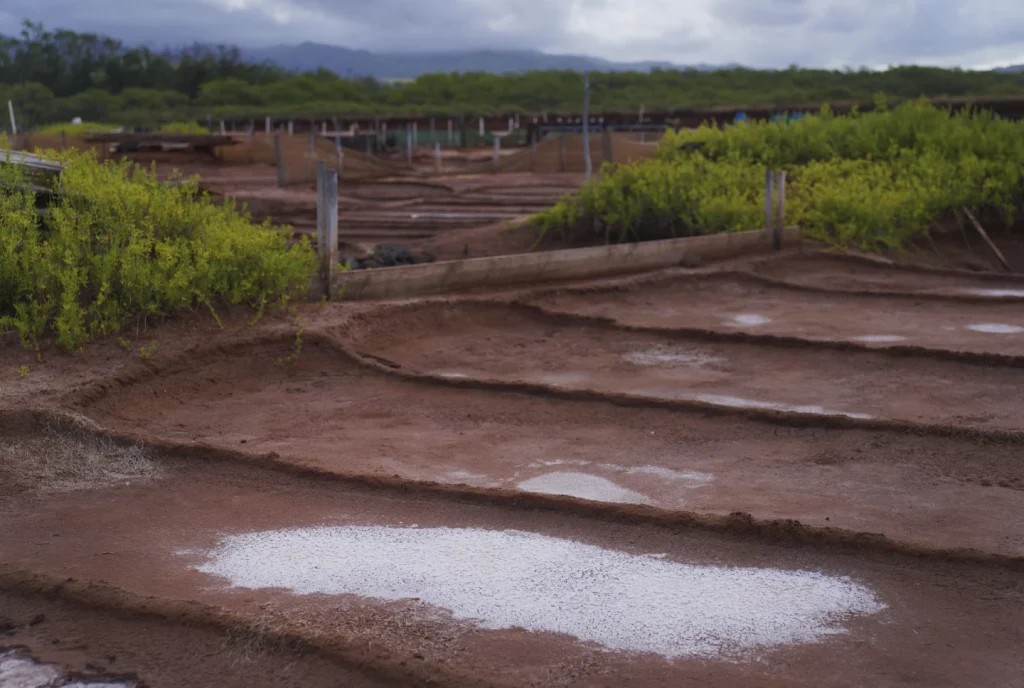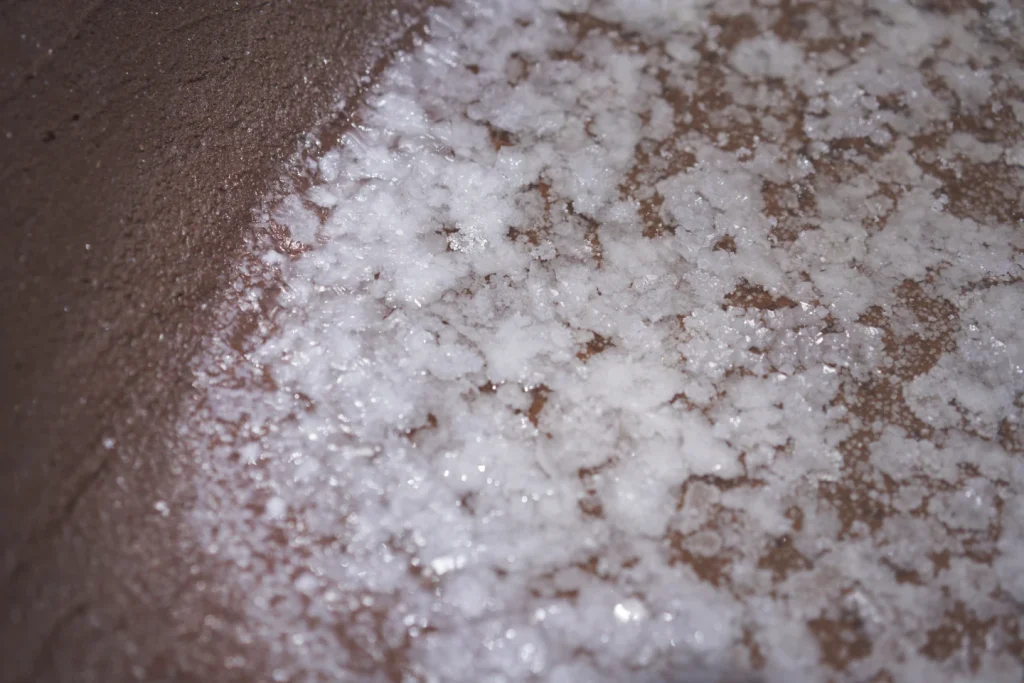The process of making salt from sea water in Hanapepe, Hawaii is a time-honored tradition that requires dedication, resilience, and a strong sense of perseverance.
This ancient practice, which has been passed down through generations of Native Hawaiian families, is a laborious and meticulous endeavor that is deeply rooted in the cultural and historical fabric of the island of Kauai.
The salt making process at the Kauai salt patch is a multi-step, intricate procedure that demands careful attention to detail and a deep understanding of the natural elements at play.
The first step in this arduous process involves the cleaning of deep wells or puna, which are essential for allowing sea water to enter through underground channels.
These wells must be meticulously maintained and kept free of dirt and debris in order to ensure that the sea water entering them is pure and suitable for salt production.
Once the wells are prepared, the next step in the process involves smoothing out the salt beds, known as loi, using river rocks.
This step is crucial for sealing the rich black clay and mud mixture that forms the foundation of the salt beds.
The meticulous smoothing of the loi is essential for creating an environment that is conducive to the evaporation of sea water and the subsequent formation of salt crystals.
The salt making process at the Kauai salt patch is not only labor-intensive, but also highly vulnerable to the whims of Mother Nature.
Passing rain showers, which are common occurrences on the island of Kauai, pose a significant threat to the hours or even days of work that salt makers invest in the production of salt.
Despite the challenges posed by the weather, the salt makers of Kauai approach their work with a sense of stoicism and resilience, understanding that their efforts are part of a tradition that has withstood the test of time.
In conclusion, the process of making salt from sea water at the Kauai salt patch is a testament to the enduring spirit and cultural heritage of the Native Hawaiian families who have practiced this ancient tradition for centuries.
The dedication, patience, and perseverance required for salt making reflect the deep connection that the people of Kauai have to their land and the natural elements that sustain them.
This time-honored practice serves as a reminder of the enduring traditions that continue to shape the cultural identity of the island of Kauai.
The process of traditional salt making is a fascinating and intricate practice that has been passed down through generations.
From the initial extraction of sea water to the final drying and harvesting of salt crystals, each step requires careful attention and skill.
In this essay, we will delve into the various stages of this age-old craft, exploring the methods and techniques employed by salt makers to produce high-quality salt.
Step 3 marks the beginning of the salt making process, as sea water is drawn from wells and transferred to rectangular holding tanks, or waiku.
These tanks serve as the initial stage of evaporation, allowing the brine to slowly concentrate and salt crystals to form on the surface.
The precise management of this evaporation process is crucial in determining the quality and quantity of salt produced.
Moving on to Step 4, the salt maker gently pours the concentrated brine from the holding tanks into drying beds.
This stage is pivotal in facilitating further evaporation and crystallization of the salt. The controlled transfer of the brine to the drying beds is essential to ensure an even distribution, allowing for uniform salt formation.
Step 5 involves the gradual evaporation of water from the drying beds, resulting in the formation of slushy layers of white salt.
This delicate process unfolds over several weeks, requiring patience and meticulous monitoring. Once the salt begins to crystallize, it is carefully and slowly raked from the drying beds, with large flakes being transferred to baskets for further processing.
In Step 6, the harvested salt undergoes a rinsing process, where it is dipped back into sea water to remove any debris or impurities.
This meticulous cleaning stage is crucial for achieving a pure and high-quality final product. The attention to detail and dedication exhibited during this step is a testament to the salt maker’s commitment to excellence.
Following the rinsing process, the salt is left to dry in the sun for at least four weeks, as outlined in Step 7. This final stage of drying is essential for achieving the desired texture and moisture content in the salt crystals.
The exposure to natural sunlight allows for gradual evaporation and further crystallization, resulting in a premium-grade salt ready for consumption or trade.
It is noteworthy that during a fruitful salt making year, a family may complete three harvests, repeating the same meticulous process.
This demonstrates the cyclical nature of salt production and the sustained dedication required to maintain consistent quality and quantity.
In conclusion, the art of traditional salt making encompasses a series of intricate and time-honored techniques, from the initial extraction of sea water to the final drying and harvesting of salt crystals.
Each step in the process demands precision, patience, and expertise, reflecting the deep-rooted traditions and craftsmanship of salt makers.
Through their meticulous efforts, these artisans preserve a legacy of artisanal salt production that continues to captivate and inspire.
The significance of salt in various cultures and traditions is profound. It holds a symbolic and practical value that transcends mere culinary applications.
In the case of Hanapepe salt, its cultural and spiritual importance to the Hawaiian people is deeply rooted in history and tradition.
The practice of harvesting and utilizing this salt is a sacred tradition that carries with it a set of customs and beliefs that have been passed down through generations.
The question of whether the salt can be sold is one that evokes a sense of reverence and respect for the cultural heritage associated with it.
The unequivocal answer is no; this sacred salt is not to be commercialized. It can be traded or given as a gift, but the idea of selling it runs counter to the traditional values and beliefs that have shaped the practice of salt making in Hanapepe.
The diminishing quantities of salt harvested annually serve as a poignant reminder of the need to preserve this age-old tradition.
In the past, Hanapepe salt was distributed in generous quantities, with families offering 5-gallon buckets full of this precious substance.

However, the present reality paints a starkly different picture, as the salt is now distributed in modest portions, often packaged in sandwich bags.
This drastic reduction in availability underscores the need to safeguard the production and distribution of Hanapepe salt for future generations.
The multifaceted uses of Hanapepe salt further underscore its cultural and spiritual significance. In Hawaiian culture, this salt is employed in cooking, healing practices, rituals, and as a form of protection.
The distinct variations in color – white for table salt, pink for cooking, and red for rituals and blessings – reflect the nuanced ways in which the salt is integrated into various aspects of life.
However, it is important to note that the specific usage of the salt may vary based on the cultural or spiritual context, emphasizing the intricate nature of its role within Hawaiian traditions.
Malia Nobrega-Olivera’s dedicated efforts to preserve the sacred tradition of Hanapepe salt exemplify the ongoing commitment to safeguarding cultural heritage.
Her belief in the salt’s ability to ward off negative energy underscores the deep-rooted spiritual significance attributed to this natural resource.
The recent events following the devastating Maui fires serve as a poignant example of the salt’s profound impact.
Spiritual practitioners specifically requested white Hanapepe salt to bless and soothe the traumatized island, particularly in areas housing makeshift morgues.
This demonstration of the salt’s healing and calming properties serves as a testament to its enduring relevance and importance within the Hawaiian cultural landscape.
The ongoing efforts of the salt makers to share their knowledge and support the survivors of the Maui fires highlight the interconnectedness of the Hawaiian community and the enduring role of Hanapepe salt in times of adversity.
The intention to visit Maui and impart their expertise on salt making further emphasizes the collaborative spirit that underpins the preservation of this sacred tradition.

In conclusion, the preservation of Hanapepe salt is not merely a matter of safeguarding a culinary ingredient, but rather a concerted effort to uphold a sacred tradition that is deeply intertwined with the cultural and spiritual fabric of Hawaiian society.
The imperative to protect and honor the customs and beliefs associated with this salt serves as a testament to the enduring legacy of cultural heritage and the profound significance of traditions that have withstood the test of time.
As custodians of this sacred tradition, it is incumbent upon the community to ensure that the legacy of Hanapepe salt endures for generations to come.
